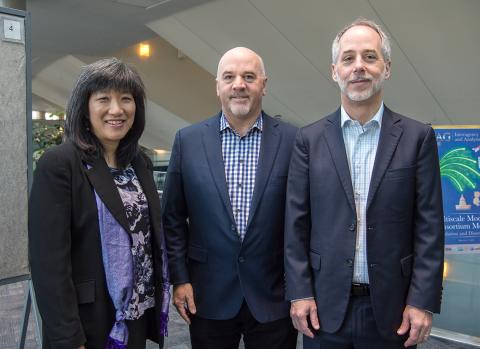Tromberg Touts Computational Modeling at Meeting

Photo: Leslie Kossoff
How can mathematical models that are developed on computers and in laboratories be translated for decisionmaking in the clinic and operating room, or for government policies and disseminated to experimental researchers and K-12 students? Federal program officers and federally supported researchers in computational modeling addressed this question at the Interagency Modeling and Analysis Group (IMAG) 2019 Multiscale Modeling Consortium annual meeting, a 2-day event held at NIH recently.
The 12th annual meeting focused on translation and dissemination of models and had more than 500 attendees in person and watching online.
The consortium—nearly 400 investigators who conduct modeling and analysis of biomedical, biological and behavioral systems—partners with IMAG, composed of more than 100 program officers from more than 10 agencies of the federal government who promote this research. Their joint efforts are represented in the more than 100 modeling and computational analysis projects underway in federally supported laboratories.
NIBIB director Dr. Bruce Tromberg, in his first official talk to a workshop at NIH since arriving in January, conveyed great enthusiasm for the opportunities surrounding multiscale modeling and computation in biomedical sciences.
“As many of you who are developing technologies know, it’s important to commercialize and disseminate,” he said. “This is a wonderful opportunity to get something that works and get it into the hands of lots of people.”
His research, prior to taking the helm of NIBIB, has entailed multiscale imaging and technology development—from macroscopic, to microscopic, to molecular imaging. He envisions opportunities, working with modelers, to predict outcomes for patients.
He explained the potential of bioimaging combined with measurement to detect physical properties of tissue, including composition, perfusion, metabolism, structural features, cell sizes and the size and density of scattering particles. “All of these things are absolutely model-dependent,” he said.

Photo: Leslie Kossoff
Tromberg told the audience that his most widely cited scientific article, published in 1994 and now having 1,300 citations, turns out to have been a paper in which modeling and computation underpinned an important imaging framework.
He reasoned, however, that models must then be converted into instrumentation and technologies. In one example, his work has been applied to develop an optical technique that can detect tumor tissue in the breast and help predict the patient’s response to therapy.
Now, at NIBIB, Tromberg believes that modeling and data science are an essential tool driving innovation in technologies to advance synthetic biology, development of point-of-care, wearable and implantable devices, imaging instrumentation and therapeutic tools and systems. He also has already been tapped to co-chair the strategic planning committee for the NIH Data Science Initiative, where he sees an opportunity to apply computational modeling.
“There is going to be broader, more widespread access to these established, multiscale NIH datasets that are enormously valuable and will drive remarkable research and discovery,” he said.
“This is going to accelerate the development of new analytical tools and standards for the modeling community.”
